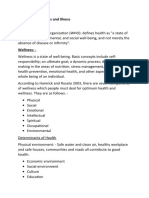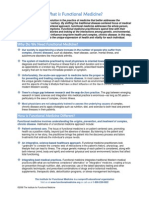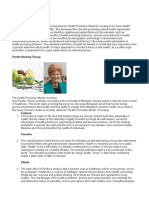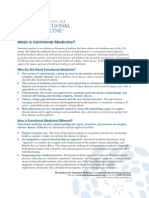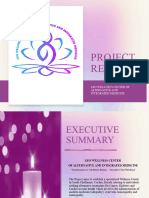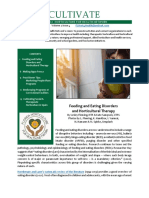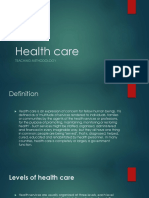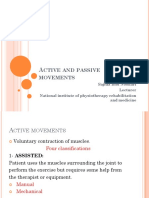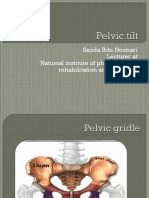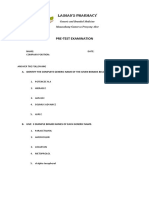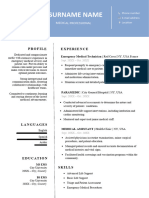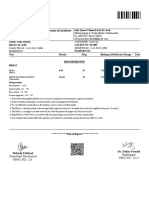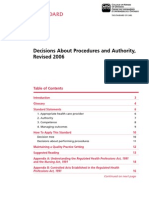0 ratings0% found this document useful (0 votes)
59 viewsHealth: Draishasultana PT, DPT Lecturer Institute of Physiotherapy and Rehabilitation Sciences Lumhsjamshoro
Health: Draishasultana PT, DPT Lecturer Institute of Physiotherapy and Rehabilitation Sciences Lumhsjamshoro
Uploaded by
Sajida Bibi NoonariThis document defines health and its determinants. It provides 3 definitions of health from different sources that describe health as involving physical, mental, and social well-being. It then lists several determinants of health, including income, social support, education, physical environment, genetics, personal behaviors, health services, and gender. The document concludes by comparing holistic and conventional medicine, noting their different philosophies, objectives, diagnostic methods, treatment options, strengths, and weaknesses.
Copyright:
© All Rights Reserved
Available Formats
Download as PPTX, PDF, TXT or read online from Scribd
Health: Draishasultana PT, DPT Lecturer Institute of Physiotherapy and Rehabilitation Sciences Lumhsjamshoro
Health: Draishasultana PT, DPT Lecturer Institute of Physiotherapy and Rehabilitation Sciences Lumhsjamshoro
Uploaded by
Sajida Bibi Noonari0 ratings0% found this document useful (0 votes)
59 views12 pagesThis document defines health and its determinants. It provides 3 definitions of health from different sources that describe health as involving physical, mental, and social well-being. It then lists several determinants of health, including income, social support, education, physical environment, genetics, personal behaviors, health services, and gender. The document concludes by comparing holistic and conventional medicine, noting their different philosophies, objectives, diagnostic methods, treatment options, strengths, and weaknesses.
Original Description:
health and wellness
Original Title
Lecture 1 Health
Copyright
© © All Rights Reserved
Available Formats
PPTX, PDF, TXT or read online from Scribd
Share this document
Did you find this document useful?
Is this content inappropriate?
This document defines health and its determinants. It provides 3 definitions of health from different sources that describe health as involving physical, mental, and social well-being. It then lists several determinants of health, including income, social support, education, physical environment, genetics, personal behaviors, health services, and gender. The document concludes by comparing holistic and conventional medicine, noting their different philosophies, objectives, diagnostic methods, treatment options, strengths, and weaknesses.
Copyright:
© All Rights Reserved
Available Formats
Download as PPTX, PDF, TXT or read online from Scribd
Download as pptx, pdf, or txt
0 ratings0% found this document useful (0 votes)
59 views12 pagesHealth: Draishasultana PT, DPT Lecturer Institute of Physiotherapy and Rehabilitation Sciences Lumhsjamshoro
Health: Draishasultana PT, DPT Lecturer Institute of Physiotherapy and Rehabilitation Sciences Lumhsjamshoro
Uploaded by
Sajida Bibi NoonariThis document defines health and its determinants. It provides 3 definitions of health from different sources that describe health as involving physical, mental, and social well-being. It then lists several determinants of health, including income, social support, education, physical environment, genetics, personal behaviors, health services, and gender. The document concludes by comparing holistic and conventional medicine, noting their different philosophies, objectives, diagnostic methods, treatment options, strengths, and weaknesses.
Copyright:
© All Rights Reserved
Available Formats
Download as PPTX, PDF, TXT or read online from Scribd
Download as pptx, pdf, or txt
You are on page 1of 12
HEALTH
DR AISHA SULTANA PT ,DPT
LECTURER
INSTITUTE OF PHYSIOTHERAPY AND
REHABILITATION SCIENCES
LUMHS JAMSHORO
DEFINING HEALTH
Health is the level of functional or metabolic efficiency
of a living being. In humans, it is the general condition
of a person's mind and body, usually meaning to be
free from illness, injury or pain (as in "good health" or
"healthy").
Health is broadly defined by Webster Dictionary as
“ the state of being healthy, happy and prosperous”
The World Health Organization (WHO) defined health
as:
“A state of complete physical, mental, and social well-
being and not merely the absence of disease or
infirmity."
Defined in community health and education and
promotion manual, health is a more dynamic process,
“a quality of life involving dynamic interaction and
independence among an individual’s physical well
being, his/her mental and emotional reactions, and the
social complex in which he/she exists”
DETERMINANTS OF HEALTH
Income and social status - higher income and social status
are linked to better health. The greater the gap between the
richest and poorest people, the greater the differences in
health.
Social support networks – greater support from families,
friends and communities is linked to better health. Culture -
customs and traditions, and the beliefs of the family and
community all affect health.
Education – low education levels are linked with poor
health, more stress and lower self-confidence.
Physical environment – safe water and clean air, healthy
workplaces, safe houses, communities and roads all
contribute to good health. Employment and working
conditions – people in employment are healthier,
particularly those who have more control over their working
conditions
Genetics - inheritance plays a part in determining
lifespan, healthiness and the likelihood of developing
certain illnesses. Personal behavior and coping skills –
balanced eating, keeping active, smoking, drinking, and
how we deal with life’s stresses and challenges all affect
health.
Health services - access and use of services that prevent
and treat disease influences health
Gender - Men and women suffer from different types of
diseases at different ages.
PREDICTIONS OF HEALTHCARE
We Will Cure Cancer, Strokes, Diabetes and Alzheimer's
Disease.
Predictions on Weight Loss and Diet
The future of medical implants demands that the body
recognize these devices as "natural.“
Bloodless, Sterile, Painless Surgery.
Unique biological materials will substitute for tooth
structure without the need for drilling and entire
replacements for the teeth will be grown in the jaw.
Looking Inside the Brain
Killing Brain Tumors with Antibodies
COMPARING HOLLISTIC MEDICINE AND
CONEVNTIONAL MEDICINE
HOLLISTIC MEDICINE CONVENTIONAL
MEDICINE
Philosophy Based on the integration of Based on allopathic
allopathic (MD), osteopathic medicine.
(DO), naturopathic (ND),
energy, and ethno-medicine.
Primary To promote optimal health To cure or reduce pathology
Objective of To prevent and treat disease.
Care
Primary Empower patients to heal Focus on the elimination of
Method of themselves by addressing the sign and symptoms.
Care causes of their disease and
facilitating lifestyle changes
through health promotion.
Diagnosis Evaluate the whole person Evaluate the body with
through medical history, history, physical exam, lab
holistic health care sheet, data.
physical exam, lab data.
HOLLISTIC MEDICINE CONVENTIONAL
MEDICINE
Primary diet, exercise, environmental Drugs and surgery
Care measures, attitudinal and behavioral
Treatment modifications, relationship and
Options spiritual counseling
Secondary Botanical (herbal) medicine, Diet, exercise, physical
Care homeopathy, acupuncture, manual therapy, and stress
Treatment medicine, biomolecular therapies, management.
Options physical therapy, drugs, and surgery.
Weaknesses Shortage of holistic physicians and Ineffective in preventing
training programs; time-intensive, and curing chronic
requiring a commitment to a healing disease; expensive.
process, not a quick-fix.
Strengths Teaches patients to take responsibility Highly therapeutic in
for their own health, and in so doing treating both acute and
is: cost-effective in treating both acute life-threatening illness
and chronic illness; therapeutic in and injuries.
preventing and treating chronic
disease; essential in creating optimal
health.
THANK YOU
You might also like
- Concepts of Man Health and IllnessDocument48 pagesConcepts of Man Health and IllnessMartD Recalde83% (6)
- Quick Selection of Chinese Herbal Formulas Based On Clinical ConditionsDocument0 pagesQuick Selection of Chinese Herbal Formulas Based On Clinical Conditionsharbor100% (1)
- CH 1-Prevention PracticeDocument24 pagesCH 1-Prevention PracticeHafsa AzizNo ratings yet
- Disease Reversal and Prevention Digest, Issue #1, 2019 SpringDocument90 pagesDisease Reversal and Prevention Digest, Issue #1, 2019 Springcharlesincharge100% (1)
- Fresh Graduate Nurse Resume Example Position OverviewDocument8 pagesFresh Graduate Nurse Resume Example Position OverviewShofi AlfiyyahNo ratings yet
- Health & Wellness Introduction.Document37 pagesHealth & Wellness Introduction.Shimmering MoonNo ratings yet
- CH 1nwnjsjwkwDocument24 pagesCH 1nwnjsjwkwandrew.l0x0lNo ratings yet
- The Science of Natural HealingDocument3 pagesThe Science of Natural HealingMihaela Ava100% (1)
- Health & Wellness: Prevention Practice: A Holistic Perspective For Physical TherapyDocument31 pagesHealth & Wellness: Prevention Practice: A Holistic Perspective For Physical TherapyShimmering MoonNo ratings yet
- Concept of Wellness and IllnessDocument6 pagesConcept of Wellness and IllnessGomathi SharmaNo ratings yet
- Naturopathy Notes Part 1Document2 pagesNaturopathy Notes Part 1Zero OneNo ratings yet
- Health Education ReviewerDocument3 pagesHealth Education ReviewerMarylene Conge AbantaoNo ratings yet
- What Is Functional MedicineDocument2 pagesWhat Is Functional MedicineimanfekryahmedNo ratings yet
- Health Psychology: Bio Psychosocial Perspective: Ranya Al-Mandawi Dr. Tyrin Stevenson Psych 331Document6 pagesHealth Psychology: Bio Psychosocial Perspective: Ranya Al-Mandawi Dr. Tyrin Stevenson Psych 331Ranya NajiNo ratings yet
- The Essential Barbara O'Neill Guide to Natural Healing and Herbal Remedies: The Complete Handbook for Nutrition, Exercise, Herbal Safety, and Natural Ailment ReliefFrom EverandThe Essential Barbara O'Neill Guide to Natural Healing and Herbal Remedies: The Complete Handbook for Nutrition, Exercise, Herbal Safety, and Natural Ailment ReliefNo ratings yet
- Evolução Dso Modelos de Assistência MédicaDocument9 pagesEvolução Dso Modelos de Assistência MédicaDaniel SousaNo ratings yet
- Medical Definition of BiomedicalDocument4 pagesMedical Definition of BiomedicalRishel Mae Besinga PantallanoNo ratings yet
- 225 Lesson 1&2 - MergedDocument24 pages225 Lesson 1&2 - MergedNing BalderasNo ratings yet
- Introduction To CPH and History of Public Health IDocument6 pagesIntroduction To CPH and History of Public Health IReynajane TugadiNo ratings yet
- Introduction To Health Illness and DiseaseDocument10 pagesIntroduction To Health Illness and DiseaseAmmar BhattiNo ratings yet
- Holistic Herbal Medicine for Modern Chronic DiseasesFrom EverandHolistic Herbal Medicine for Modern Chronic DiseasesNo ratings yet
- 2lec wk2Document10 pages2lec wk2claire yowsNo ratings yet
- Pender's TheoryDocument8 pagesPender's Theorycarendleon93% (15)
- Promotion in Nursing Practice (1982) - She Developed The Idea That Promoting Optimal Health SupersedesDocument8 pagesPromotion in Nursing Practice (1982) - She Developed The Idea That Promoting Optimal Health SupersedeskramprincessNo ratings yet
- HW310 Unit 9 AssignDocument10 pagesHW310 Unit 9 AssignlyannivillanuevaNo ratings yet
- How To Cure The Sick Health Care System: An Open Letter To President Trump From Leaders in Functional/Integrative/Natural Health and MedicineDocument4 pagesHow To Cure The Sick Health Care System: An Open Letter To President Trump From Leaders in Functional/Integrative/Natural Health and MedicineMuhammad Salah AliNo ratings yet
- ID Pencegahan Dan Promosi Kesehatan Secara Tradisional Untuk Peningkatan Status MasDocument10 pagesID Pencegahan Dan Promosi Kesehatan Secara Tradisional Untuk Peningkatan Status MasFajar MNo ratings yet
- Metabolic Typing InfoDocument12 pagesMetabolic Typing InfoPetra Jobova100% (1)
- Notes To Read 1Document4 pagesNotes To Read 1Rizzy UgayNo ratings yet
- Self-Care of The DoctorDocument2 pagesSelf-Care of The DoctorShahnaz AhmedNo ratings yet
- What Is LM FNLDocument2 pagesWhat Is LM FNLJAVIER ARELLANONo ratings yet
- Group 1 Health Concepts Write UpDocument5 pagesGroup 1 Health Concepts Write UpEdrea Sten LumangaNo ratings yet
- Health Education Topic1Document4 pagesHealth Education Topic1Capuli, Rian Josh G.No ratings yet
- Principles of Health Promotion: DR Celine MurrinDocument40 pagesPrinciples of Health Promotion: DR Celine MurrinKatie NolanNo ratings yet
- Functional Medicine 005Document1 pageFunctional Medicine 005Iu IianoNo ratings yet
- CHN unit I 5thsemDocument35 pagesCHN unit I 5thsemmaniswarna943No ratings yet
- Naturopathic Medicine: By: Beverlyn C. Bagolos and Marianne MacanlayDocument19 pagesNaturopathic Medicine: By: Beverlyn C. Bagolos and Marianne Macanlaynicole cenaNo ratings yet
- Med Surge Edit 4.Document6 pagesMed Surge Edit 4.okedumgodswillNo ratings yet
- Health Belief and Health PracticesDocument18 pagesHealth Belief and Health Practicesk ucheNo ratings yet
- Health & IllnessDocument20 pagesHealth & IllnessAlessandra Marigold Aguilar Perez100% (1)
- Health Education Prelims TopicsDocument36 pagesHealth Education Prelims TopicsAmiel Francisco ReyesNo ratings yet
- World Health OrganizationDocument27 pagesWorld Health OrganizationrhazamNo ratings yet
- Candj 169Document7 pagesCandj 169joovinkennedy1992No ratings yet
- Concept of Health and IllnessDocument28 pagesConcept of Health and IllnessCeline Eliz Ang86% (7)
- Leo Wellness CenterDocument18 pagesLeo Wellness CenterleolifespaceNo ratings yet
- Health and IllnessDocument71 pagesHealth and IllnessLondho Londho100% (2)
- Chapter 1-Concept of Health & IllnessDocument117 pagesChapter 1-Concept of Health & IllnessJAHERA NACO100% (1)
- NCM 103 Fundamentals of Nursing: Concepts of Health and IllnessDocument19 pagesNCM 103 Fundamentals of Nursing: Concepts of Health and Illnesssharahcatherine romana100% (3)
- Why Community Medicine?Document54 pagesWhy Community Medicine?Saher ShahzadNo ratings yet
- BPS Model of HealthDocument8 pagesBPS Model of HealthSvetlana ChesserNo ratings yet
- Health ModelsDocument3 pagesHealth ModelsRichard RawatNo ratings yet
- Why is being healthy a Responsibility_Gp presentation(Final)Document12 pagesWhy is being healthy a Responsibility_Gp presentation(Final)aditya.suraj.agrawalNo ratings yet
- Holistic ModelDocument20 pagesHolistic ModelAnusha Verghese86% (7)
- Fall 2022 CultivateDocument15 pagesFall 2022 CultivateFlorida Horticulture for Health NetworkNo ratings yet
- Health: Quarter 1-Module 4Document14 pagesHealth: Quarter 1-Module 4Rogelio CayabyabNo ratings yet
- Different Characteristics Between Health Promotion and Disease PreventionDocument4 pagesDifferent Characteristics Between Health Promotion and Disease PreventionScribdTranslationsNo ratings yet
- H.P (UNIT - 2)Document12 pagesH.P (UNIT - 2)pawan976sharmaNo ratings yet
- 5. Health, Wellness, IllnessDocument26 pages5. Health, Wellness, IllnessAbdullah A. Abu ElyyanNo ratings yet
- CHN Module 1Document5 pagesCHN Module 1jaoNo ratings yet
- Topic 24 Health Diagnosis, Prevention, and HealingDocument3 pagesTopic 24 Health Diagnosis, Prevention, and HealingMarilyn DizonNo ratings yet
- Health: Needs of Good HealthDocument6 pagesHealth: Needs of Good HealthRahul GuptaNo ratings yet
- Nola Pender Health Promotion ModelDocument7 pagesNola Pender Health Promotion ModelIresef LariosaNo ratings yet
- Epidemiology: Dr. Gulzar Usman MBBS, MPH, (PHD) Assistant Professor Department of Community Medicine LumhsDocument15 pagesEpidemiology: Dr. Gulzar Usman MBBS, MPH, (PHD) Assistant Professor Department of Community Medicine LumhsSajida Bibi NoonariNo ratings yet
- Communicable and Non-Communicable DiseaseDocument44 pagesCommunicable and Non-Communicable DiseaseSajida Bibi NoonariNo ratings yet
- Dr. Bakhtawar Samejo PT Lecture # 1 Kinisiology Ii Batch 2 Topic: Voluntary Movements Involuntary Movements Active Movements Passive MovementsDocument8 pagesDr. Bakhtawar Samejo PT Lecture # 1 Kinisiology Ii Batch 2 Topic: Voluntary Movements Involuntary Movements Active Movements Passive MovementsSajida Bibi NoonariNo ratings yet
- Concept of Health and Disease - GulzarDocument18 pagesConcept of Health and Disease - GulzarSajida Bibi NoonariNo ratings yet
- 1-Health Education - Intro, Aims & ScopeDocument18 pages1-Health Education - Intro, Aims & ScopeSajida Bibi NoonariNo ratings yet
- Health Care: Teaching MethodologyDocument11 pagesHealth Care: Teaching MethodologySajida Bibi NoonariNo ratings yet
- Dubai Online Interview QuestionnaireDocument1 pageDubai Online Interview QuestionnaireSajida Bibi NoonariNo ratings yet
- Lecture 6 Walking-AidsDocument63 pagesLecture 6 Walking-AidsSajida Bibi Noonari50% (2)
- Lecture 6 EthicsDocument24 pagesLecture 6 EthicsSajida Bibi NoonariNo ratings yet
- Lecture 5 Health Care OrganizationsDocument24 pagesLecture 5 Health Care OrganizationsSajida Bibi NoonariNo ratings yet
- Sajida Bibi NoonariDocument39 pagesSajida Bibi NoonariSajida Bibi NoonariNo ratings yet
- Mental FitnessDocument23 pagesMental FitnessSajida Bibi NoonariNo ratings yet
- Lecture 3 Androgogy and PedagogyDocument17 pagesLecture 3 Androgogy and PedagogySajida Bibi NoonariNo ratings yet
- Balance Training Pt. 4 - Balance Recovery StrategiesDocument2 pagesBalance Training Pt. 4 - Balance Recovery StrategiesSajida Bibi NoonariNo ratings yet
- Pathological and Physiological Age-Related ChangesDocument39 pagesPathological and Physiological Age-Related ChangesSajida Bibi NoonariNo ratings yet
- Lec6 GONIOMETRYDocument9 pagesLec6 GONIOMETRYSajida Bibi NoonariNo ratings yet
- The Elbow and Forearm: Sajida Bibi NoonariDocument10 pagesThe Elbow and Forearm: Sajida Bibi NoonariSajida Bibi NoonariNo ratings yet
- Lec7 Active and Passive MovementsDocument19 pagesLec7 Active and Passive MovementsSajida Bibi NoonariNo ratings yet
- Lec 9active & Passive InsufficiencyDocument32 pagesLec 9active & Passive InsufficiencySajida Bibi Noonari75% (4)
- Kinesiology: Basic InformationDocument20 pagesKinesiology: Basic InformationSajida Bibi NoonariNo ratings yet
- Lec 2Document24 pagesLec 2Sajida Bibi NoonariNo ratings yet
- Intro 2rehabilitationDocument25 pagesIntro 2rehabilitationSajida Bibi NoonariNo ratings yet
- Active and Passive MovementsDocument20 pagesActive and Passive MovementsSajida Bibi Noonari57% (7)
- Sajida Bibi Noonari Lecturer at National Institute of Physiotherapy Rehabilitation and MedicineDocument46 pagesSajida Bibi Noonari Lecturer at National Institute of Physiotherapy Rehabilitation and MedicineSajida Bibi NoonariNo ratings yet
- Parenteral InjectionsDocument7 pagesParenteral InjectionsNashleyah Anayatin100% (1)
- Surgery Cases: CASE 2: Chest Abdominal TraumaDocument3 pagesSurgery Cases: CASE 2: Chest Abdominal TraumaGio Tamaño BalisiNo ratings yet
- Society For Obesity and Bariatric Anaesthesia: OS-MRS Calculator Tools - Farmacologiaclinica.infoDocument1 pageSociety For Obesity and Bariatric Anaesthesia: OS-MRS Calculator Tools - Farmacologiaclinica.infoHizami Norddin100% (2)
- Laiman'S Pharmacy: Pre-Test ExaminationDocument3 pagesLaiman'S Pharmacy: Pre-Test ExaminationChristine PaulineNo ratings yet
- Example BrochureDocument2 pagesExample BrochureChristian Elvira BerryNo ratings yet
- Psychiatric InterviewDocument12 pagesPsychiatric Interviewkiran mahal0% (1)
- D DimerDocument3 pagesD DimerniketaNo ratings yet
- Annotated ReadingDocument1 pageAnnotated Readingjhan grabierNo ratings yet
- Alcoholic Liver DiseaseDocument70 pagesAlcoholic Liver Diseaseaannaass nNo ratings yet
- (FREE PDF Sample) Textbook of Gastrointestinal Oncology Suayib Yalcin EbooksDocument49 pages(FREE PDF Sample) Textbook of Gastrointestinal Oncology Suayib Yalcin Ebookspypersthad100% (5)
- 265 Medical Resume ExampleDocument3 pages265 Medical Resume ExampleHemaang SehgalNo ratings yet
- Cemacube MCDocument1 pageCemacube MCZulfayandiPawanisNo ratings yet
- RabeprazoleDocument7 pagesRabeprazoleعبدالمحسن علي ENo ratings yet
- P S L Gy: Posology and Dosage RegimenDocument7 pagesP S L Gy: Posology and Dosage RegimenRaj Kumar SoniNo ratings yet
- Initial Presentation and Management of Pediatric Heart FailureDocument7 pagesInitial Presentation and Management of Pediatric Heart FailurePrasenjitRaneNo ratings yet
- Uma ThapaDocument1 pageUma ThapaBhaktivedanta HospitalNo ratings yet
- Prof. Husni - Paracetamol As A Basic Multimodal AnalgesiaDocument45 pagesProf. Husni - Paracetamol As A Basic Multimodal AnalgesiaPingKikiNo ratings yet
- 51 Diseases of Ruminants - Dr. SulaDocument92 pages51 Diseases of Ruminants - Dr. SulaCholid Mawardi100% (1)
- Learning Plan FormDocument2 pagesLearning Plan FormAbigail ShoukatNo ratings yet
- HEALTH - Q3 PPT-MAPEH10 - Lesson 2 (Positive Impact of Global Health Initiatives)Document23 pagesHEALTH - Q3 PPT-MAPEH10 - Lesson 2 (Positive Impact of Global Health Initiatives)Angelicque EserNo ratings yet
- AmoebiasisDocument54 pagesAmoebiasistummalapalli venkateswara rao0% (1)
- Ncma 219 Rle ReviewerDocument7 pagesNcma 219 Rle ReviewerAngelica AdlawanNo ratings yet
- An Unusual Presentation of Multiple Cavitated Lung Metastases From Colon CarcinomaDocument4 pagesAn Unusual Presentation of Multiple Cavitated Lung Metastases From Colon CarcinomaGita AmeliaNo ratings yet
- Field Surgery in Total WarDocument1 pageField Surgery in Total WarersatzersatzNo ratings yet
- DecisionsDocument24 pagesDecisionsallthebest004gmailNo ratings yet
- PROGRAMAtmo 2024Document10 pagesPROGRAMAtmo 2024Valeria FuentesNo ratings yet
- Dr. Rukshanakhanal: Dental SurgeonDocument2 pagesDr. Rukshanakhanal: Dental SurgeonPrithvi ThapaNo ratings yet
- Background: Nausea and Vomiting Are Common Discomforts Experienced by 50% ofDocument7 pagesBackground: Nausea and Vomiting Are Common Discomforts Experienced by 50% ofAkib AliNo ratings yet









